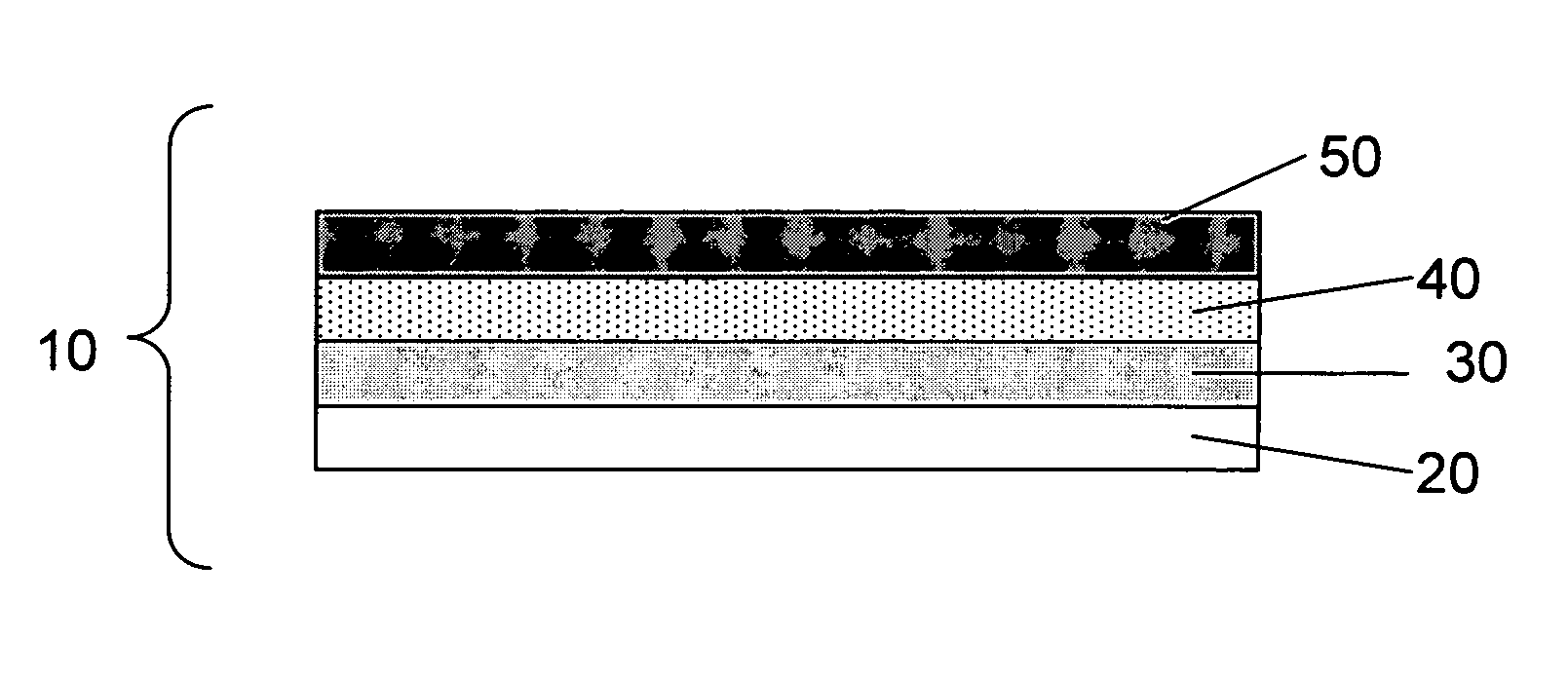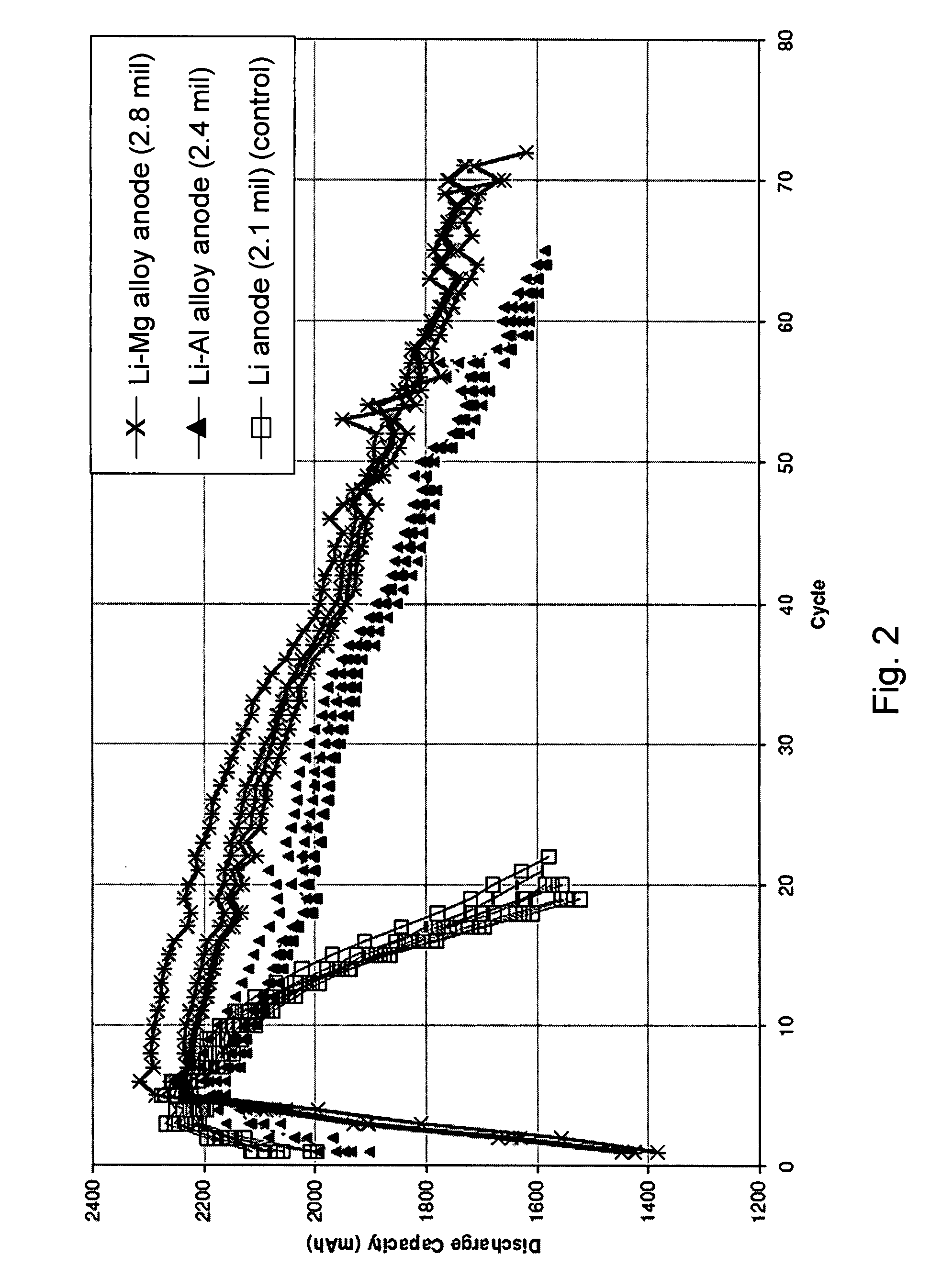Lithium alloy/sulfur batteries
a technology of lithium alloys and batteries, applied in the field of electrochemical cells, can solve the problems of many people not reducing cycling efficiency, not providing sufficient cycle lifetimes in addition to efficiency, and many others
- Summary
- Abstract
- Description
- Claims
- Application Information
AI Technical Summary
Benefits of technology
Problems solved by technology
Method used
Image
Examples
example 1
[0064]This example describes a protocol for preparing an electrochemical cell comprising a Li—Al alloy anode and a sulfur cathode including a porous, polyolefin separator, according to one embodiment of the invention. The electrochemical cell was fabricated to contain a Li—Al alloy anode, a sulfur cathode, a porous separator, and an electrolyte.
[0065]To prepare the cathode, a mixture of 73 wt % of elemental sulfur, 16 wt % of a first conductive carbon pigment, PRINTEX® XE-2, 6 wt % of a second conductive pigment, Ketjenblack®, and 5 wt % of polyethylene powder (grade T1000) dispersed in isopropanol was coated onto a 12 micron thick conductive carbon-coated aluminum / PET substrate. After drying the coated cathode active layer, the thickness of the film was measured to be about 40 microns. To prepare the electrolyte, a mixture containing 15.7 wt % of lithium bis (trifluoromethane sulfonyl) imide, 3.8 wt % lithium nitrate, 1 wt % guanidine nitrate, and 0.4 parts pyridine nitrate (synthe...
example 2
[0069]A layered structure was fabricated to contain a Li—Mg alloy anode, a cathode, a porous separator, and an electrolyte. The cell was assembled according to the general procedure described in Example 1, with the exception that the anode used was a Li—Mg alloy having 10 wt % Mg (2.8 mil thick). As a control experiment, cells containing a lithium metal anode were also prepared. The general procedure described above was followed, except that the anodes used were >99.9% Li metal (3.0 mil thick foil).
[0070]As shown in FIG. 3, upon cycling, the cells containing the Li—Mg alloy anodes performed 70 cycles to 1600 mAh (about 74% of the 6th cycle capacity). By contrast, the cells containing the lithium metal anodes (control) performed on 64 cycles to 1600 mAh (approximately 75% of the 6th cycle capacity).
example 3
[0071]Prismatic cells was fabricated to contain a Li—Al alloy anode, a cathode, a porous separator, and an electrolyte. The cell was assembled according to the general procedure described in Example 1, with the exception that the anode used was a Li—Al alloy having 0.2 wt % Al (1.93 mil thick), and the cells were activated with 7.6 g of a DOL / DME based electrolyte containing 40 wt % DOL, 40 wt % DME, 16.5 wt % LiTFSI, 2.1 wt % LiNO3, 1% guanidine nitrate, and 0.4% pyridine nitrate. As a control experiment, cells containing a lithium metal anode were also prepared. The general procedure described above was followed, except that the anodes used were >99.9% Li metal (2.1 mil thick).
[0072]As shown in FIG. 4, upon cycling, the cells containing the Li—Al alloy anodes performed 70 cycles to 1800 mAh (about 80% of the early cycle capacity). By contrast, the cells containing the lithium metal anodes (control) performed on 40 cycles to 1800 mAh (approximately 80% of the early cycle capacity)....
PUM
| Property | Measurement | Unit |
|---|---|---|
| thickness | aaaaa | aaaaa |
| area | aaaaa | aaaaa |
| voltage | aaaaa | aaaaa |
Abstract
Description
Claims
Application Information
 Login to View More
Login to View More - R&D
- Intellectual Property
- Life Sciences
- Materials
- Tech Scout
- Unparalleled Data Quality
- Higher Quality Content
- 60% Fewer Hallucinations
Browse by: Latest US Patents, China's latest patents, Technical Efficacy Thesaurus, Application Domain, Technology Topic, Popular Technical Reports.
© 2025 PatSnap. All rights reserved.Legal|Privacy policy|Modern Slavery Act Transparency Statement|Sitemap|About US| Contact US: help@patsnap.com



